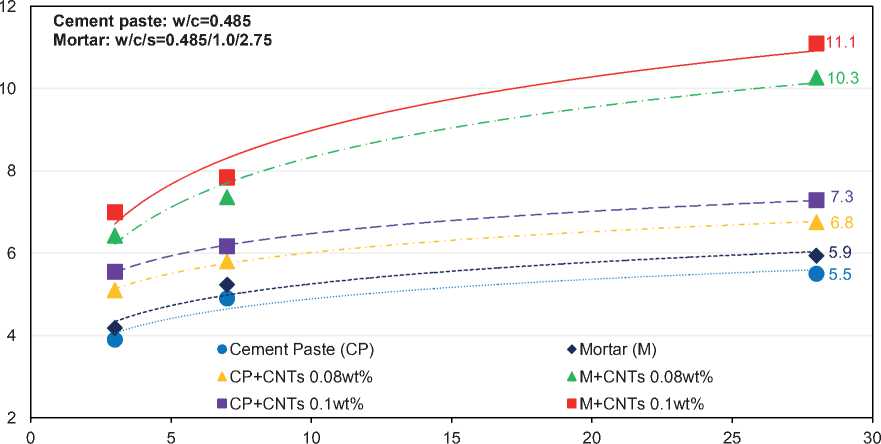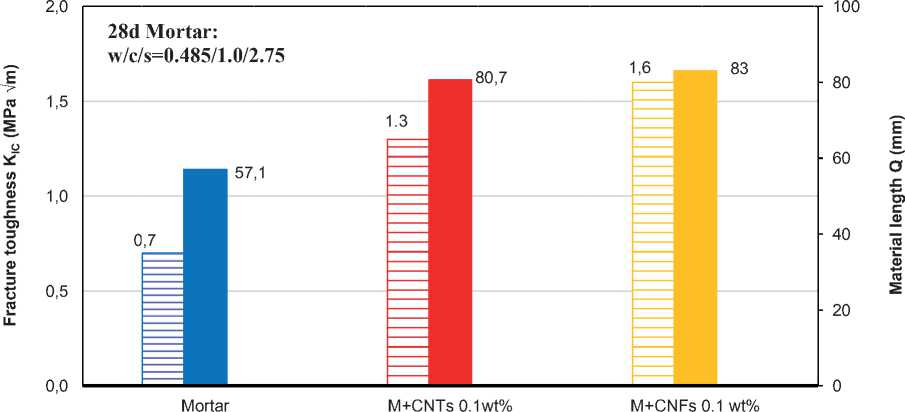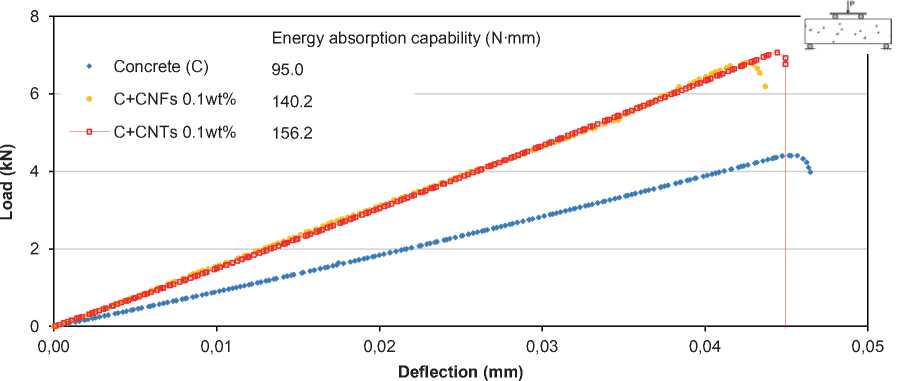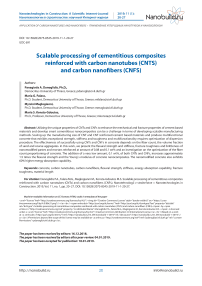Scalable processing of cementitious composites reinforced with carbon nanotubes (CNTS) and carbon nanofibers (CNFS)
Автор: Danoglidis P.A., Falara M.G., Maglogianni M., Konsta-Gdoutos M.S.
Журнал: Нанотехнологии в строительстве: научный интернет-журнал @nanobuild
Рубрика: Применение углеродных нанотрубок и нановолокон
Статья в выпуске: 1 т. 11, 2019 года.
Бесплатный доступ
Utilizing the unique properties of CNTs and CNFs to enhance the mechanical and fracture properties of cement based materials and develop smart cementitious nanocomposites can be a challenge in terms of developing scalable manufacturing methods. Scaling up the manufacturing size of CNT and CNF reinforced cement based materials and produce multifunctional concrete that exhibits exceptional strength, stiffness and toughness and multifunctionality requires optimization of dispersion procedure. The effectiveness of successfully using CNTs and CNFs in concrete depends on the fiber count, the volume fraction of sand and coarse aggregates. In this work, we present the flexural strength and stiffness, fracture toughness and brittleness of nanomodified pastes and mortars reinforced at amount of 0.08 and 0.1 wt% and an investigation on the optimization of the fiber count proportioning of concrete. The addition of a very low amount, 0.1 wt%, of both CNTs and CNFs, increases approximately 1.5 times the flexural strength and the Young`s modulus of concrete nanocomposites. The nanomodified concrete also exhibits 60% higher energy absorption capability.
Concrete, carbon nanotubes, carbon nanofibers, flexural strength, stiffness, energy absorption capability, fracture toughness, material length
Короткий адрес: https://sciup.org/142218079
IDR: 142218079 | УДК: 691 | DOI: 10.15828/2075-8545-2019-11-1-20-27
Текст научной статьи Scalable processing of cementitious composites reinforced with carbon nanotubes (CNTS) and carbon nanofibers (CNFS)
C ement-based materials have been widely used in the field of civil engineering, as one of the most durable and widely used building materials, despite their quasibrittle behaviour and low tensile strength. Many researchers so far have concentrated to increase the strength of cement pastes, mortars and concretes under compressive loading by optimizing mixture proportions or adding constituents, such as silica fume, as replacements of cement. However, the main disadvantage of conventional cement-based materials is the low fracture toughness and stiffness, which seriously affects the flexural performance, durability and safety of structures (1). Several types of fibers at the micro and macro scale are used to improve the toughness of cement-based materials by delaying the transformation of cracks. These fibers increased tensile strength and diffused large cracks into a dense of microcracks, but there was little effect in delaying crack initiation at the nanoscale (2).
With the development of nanotechnology, cement based materials can be modified by the incorporation of carbon nanotubes (CNTs) and nanofibers (CNFs) to enhance their mechanical behavior, while adding novel multifunctional characteristics as self-sensing ability (3). Carbon nanotubes (CNTs) and carbon nanofibers (CNFs) are characterized by high tensile strength and elastic modulus as well as significant electrical conductivity. During the past decade, research has been conducted towards the incorporation of carbon nanotubes and carbon nanofibers in cementitious composites. Previous research has demonstrated that the addition of multi-walled carbon nanotubes and carbon nanofibers of about 0.1 wt% of cement can greatly increase the flexural strength and the Young’s modulus of cementitious materials (3–6).
In the present work, the mechanical characteristics of cement pastes, mortars and concretes reinforced with carbon nanotubes (CNTs) or carbon nanofibers (CNFs) were investigated. Specifically, the flexural strength, stiffness, and fracture toughness, as well a brittleness index, of nanomodified pastes and mortars reinforced at an amount of 0.08 and 0.1 wt% were examined to optimize the fiber count proportioning of concrete. The addition of a very low amount, 0.1 wt%, of both CNTs and CNFs,
increases approximately 1.5 times the flexural strength and the Young`s modulus of concrete nanocomposites. The nanomodified concrete also exhibits 60% higher energy absorption capability.
EXPERIMENTAL WORK
Materials and specimens
The nanocomposites fabricated in this study are cement paste, mortar and concrete with the matrix reinforced by CNTs at amounts of 0.08 and 0.1 wt% or CNFs at an amount of 0.1 wt% of cement. Nanotubes’ and nanofibers’ dispersion was achieved by applying ultrasonic energy with the use of a surfactant (7–9). The fiber count, the number of individual nanotubes or nanofibers, which are theoretically evenly distributed in a unit volume of the matrix, assuming perfect dispersion, according to ACI 544.1R-96: Report on Fiber Reinforced Concrete (10) is also estimated. The fiber count of each cementitious mixture is included in Table 1. The cement used for all mixes is type I 42.5 ordinary Portland cement (OPC). For the mortar and concrete preparation standard sand according to EN 196 and coarse aggregates between 4 and 16 mm were used.
Experimental procedure
Three point bending tests were conducted on 40×40×160 mm prisms to assess the flexural strength and stiffness. The fracture toughness (stress intensity factor, Kic), the Young`s modulus and the index of the brittleness were investigated through fracture mechanics tests on notched 20×20×80 mm specimens following the Two Parameter Fracture Model, TPFM (4). The flexural performance, flexural strength, stiffness and toughness, of conventional concrete and concrete nanocomposites were evaluated through four point bending tests on 70×80×380 mm beams following the ASTM C293 and the ASTM C1018.
Results and discussions
The results of flexural strength tests of control specimens (pastes and mortars) and nanocomposites
Table 1
Fiber count of CNTs and CNFs in cement paste, mortar and concrete
|
Mortar |
Paste |
Concrete |
|
|
CNTs 0.08 wt% |
2.9·1011 |
6.6·1011 |
2.0·1011 |
|
CNTs 0.1 wt% |
3.6·1011 |
8.3·1011 |
2.5·1011 |
|
CNFs 0.1 wt% |
1.7·1010 |
3.8·1010 |
1.2·1010 |
Table 2
Effect of CNTs and CNFs on the Young’s modulus of 28d mortars
|
Young’s modulus (GPa) 3 Point bending |
Young`s modulus (GPa) Fracture mechanics |
|
|
Mortar |
14.1 ± 0.71 |
14.3 ± 0.69 |
|
Mortar+CNTs 0.1 wt% |
27.4 ± 0.09 |
27.5 ± 0.08 |
|
Mortar+CNFs 0.1 wt% |
27.6 ± 0.11 |
27.7 ± 0.09 |
APPLICATION OF CARBON NANOTUBES AND NANOFIBERS • ПРИМЕНЕНИЕ УГЛЕРОДНЫХ НАНОТРУБОК И НАНОВОЛОКОН

Age (Days)
Fig. 1. Rate of development of flexural strength, σf, of cement pastes (CP) and mortars (M) reinforced with 0.08 and 0.1 wt% CNTs
made with 0.08 and 0.1 wt% CNTs are shown in Fig. 1. It is observed that, the addition of 0.08 and 0.1 wt% of CNTs in cement paste increases 24% and 33% the flexural strength, respectively. The count of individual nanotubes of 0.08 and 0.1 wt% CNTs in paste is approximately three times the count of CNTs in mortar (Table 1), therefore one might expect that benefits would be less pronounced for mortar. However, it is observed that even higher increases in flexural strength in mortar nanocomposites, 75% and 88%, with the 0.08 and 0.1 wt% CNT addition, respectively.
Young`s modulus results of mortars reinforced with 0.1 wt% CNTs or CNFs, as investigated from three point bending and fracture mechanics test, are presented in Table 2. The modulus values show that the benefits associated with the addition of both nanotubes and nanofibers lead to substantial enhancements of the flexural stiffness of the nanocomposites. The increase of Young`s modulus of
both nanocomposites is approximately the same, ≈93%, despite the fact that the estimated fiber count of the CNF reinforced mortars (1.7·1010) is 21 times lower than this of the CNΤ/mortars (Table 1). To further examine the reinforcing effect of both CNTs and CNFs in the mechanical and fracture properties of mortar nanocomposites, the critical values of the fracture toughness (stress intensity factor), KIC, and the material length, Q, are investigated and presented in Figure 2.
It is observed that 0.1 wt% CNTs and CNFs increase the nanocomposites’ fracture toughness from 86% to 129%. It is also observed that the stress intensity factor of the CNF mortar is ≈23% higher than the CNT one. Taking into account that the load bearing capacity of both CNTs and CNFs is large enough, it is possible that the bigger diameter and length of the CNFs, along with the extended graphite planes that exist in the outer CNF surface (4) , create a stronger interfacial bonding between the
APPLICATION OF CARBON NANOTUBES AND NANOFIBERS • ПРИМЕНЕНИЕ УГЛЕРОДНЫХ НАНОТРУБОК И НАНОВОЛОКОН

Fig. 2. Fracture toughness and material length of 28d mortars reinforced with CNTs and CNFs at amount of 0.1 wt%
mortar matrix and the carbon nanofibers that enhances the observed toughening effect.
The material length Q is proportional to the size of the fracture process zone for the same material and can be used to characterize the brittleness of the material. The smaller the value of Q the more brittle the material is. Interestingly and despite the fact that the fracture toughness of nanomodified mortars is almost 100% higher than the plain one, the 41% and 45% increase in the index Q exhibited from the 0.1 wt% CNT and CNF/mortars, respectively, indicated a less brittle behaviour (4). Several parameters besides dispersion are considered to improve both the fracture toughness and the brittleness of the nanocomposites. These parameters include the diameter and the length of the nanoscale carbon fibers and the strength of CNT/ CNF-mortar matrix interfacial characteristics (11–12).
Flexural strength and modulus of elasticity values for concrete specimens reinforced with 0.1 wt% CNTs or CNFs are shown in Figure 3. The nanomodified concretes exhibit 1.5 times higher flexural strength, compared to the

Fig. 3. Flexural strength and Young’s modulus of 28d concrete reinforced with CNTs and CNFs at amount of 0.1 wt%
APPLICATION OF CARBON NANOTUBES AND NANOFIBERS • ПРИМЕНЕНИЕ УГЛЕРОДНЫХ НАНОТРУБОК И НАНОВОЛОКОН

Fig. 4. Load-Deflection curves of 28d concrete reinforced with 0.1 wt% CNTs and CNFs
sample without the nanoscale reinforcement. Similarly to the results of mortars, the addition of both CNTs and CNFs results in almost the same increase in strength values despite the fact that the number of individual CNFs (1.2·1010) is lower by one order of magnitude than that of CNTs (2.5·1011) (Table 1).
The extraordinary reinforcing efficiency of both types of fibers is also observed from the substantial increase in modulus of elasticity, almost 56%. There has been some indication that addition of nanotubes and nanofibers alters the nanostructure of calcium silicate hydrate (C–S–H). Moreover, it is found that CNTs and CNFs are capable of greatly improving the Young`s modulus of the interfacial transition zone (ITZ), due to their effect as a stronger link between mortar and aggregates (13).
Figure 4 presents the 4 point bending load-deflection curves of 28d concrete and 0.1 wt% CNT and CNF nanocomposites. Compared to the concrete without the nanoscale reinforcement, it is observed that a higher load is required to achieve the same deflection for all nanocomposite specimens. It is apparent that both carbon nanotube and nanofibers can effectively arrest the nanocracks, therefore a significantly higher energy for crack propagation is demanded. The nanocomposites reinforced with CNTs or CNFs at an amount of 0.1 wt% exhibit an approximately 60% increase in flexural toughness. This is in accordance with the trend already observed for the flexural strength and Young’s modulus.
CONCLUSIONS
This experimental study clearly shows that the incorporation of CNTs and CNFs in Portland cement pastes, mortars and concretes results in significant improvement in all the mechanical properties. The flexural strength, the Young’s modulus and the fracture toughness of paste and mortar nanocomposites, reinforced with well dispersed 0.08, 0.1 wt% CNTs and 0.1 wt% CNFs were experimentally determined. The addition of a very low amount of both 0.1 wt% CNTs and CNFs to the neat mortar increases nearly 1.9 times the flexural strength and 2.0 times the Young`s modulus. The strong interfaces between the mortar matrix and well dispersed carbon fibers at the nanoscale substantially enhance both strength and stiffness. The evaluation of the fracture toughness of the nanoreinforced mortars indicated that besides strength and stiffness the values of toughness are approximately 85–100% higher over the plain mortar. The effectiveness of successfully using CNTs and CNFs in concrete depends on the volume fraction of nanoscale fibers, sand and coarse aggregates. Four point bending experiments indicate that the addition of a very low amount, 0.1 wt%, of both CNTs and CNFs, increases approximately 1.5 times the flexural strength and the Young`s modulus of concrete nanocomposites. The nanomodified concrete also exhibits 60% higher energy absorption capability.
APPLICATION OF CARBON NANOTUBES AND NANOFIBERS • ПРИМЕНЕНИЕ УГЛЕРОДНЫХ НАНОТРУБОК И НАНОВОЛОКОН
Список литературы Scalable processing of cementitious composites reinforced with carbon nanotubes (CNTS) and carbon nanofibers (CNFS)
- Shah S.P.,Ouyang C. Mechanical behavior of fiberreinforced cement-based composites. Journal of the American Ceramic Society.1991, Vol. 74, no. 11, pp. 2727–2953. Available at: https://onlinelibrary.wiley.com/doi/abs/10.1111/j.1151-2916.1991.tb06836.x.
- Xu S., Li Q. Theoretical analysis on bending behavior of functionally grated composite beam crack controlled by ultrahigh toughness cementitious composites. Science in China Series E: Technological Science. 2009, Vol. 5, pp. 363–378. Available at: https://link.springer.com/article/10.1007/s11431-008-0337-9.
- Danoglidis P.A., Konsta-Gdoutos M.S., Gdoutos E., Shah S.P. Strength, energy absorption capability and self-sensing properties of multifunctional carbon nanotube reinforced mortars. Construction and Building Materials. 2016, Vol. 120, pp. 265–274. Available at: https://www.sciencedirect.com/science/article/abs/pii/S0950061816307747.
- Gdoutos E.E., Konsta-Gdoutos M.S., Danoglidis, P.A. Portland cement mortar nanocomposites at low carbon nanotube and carbon nanofiber content: Α fracture mechanics experimental study. Cement and Concrete Composites. 2016, Vol. 70, pp. 110–118. Available at: https://www.sciencedirect.com/science/article/pii/S0958946516300543.
- Abu Al-Rub R.K., Tyson M., Yasdanbakhsh, A., Grasley Z. Mechanical Properties of Nanocomposite Cement Incorporating Surface-Treated and Untreated Carbon Nanotubes and Carbon Nanofibers. Journal of Nanomechanics and Micromechanics. 2012, Vol. 2, no. 1, pp. 1–6. Available at: https://ascelibrary.org/doi/10.1061/%28ASCE%29NM.2153-5477.0000041.
- Manzur T., Yazdani, N. Optimum mix ratio for Carbon Nanotubes in cement mortar. KSCE Journal of Civil Engineering. 2015, Vol. 19, no. 5, pp. 1405–1412. Available at: https://link.springer.com/article/10.1007/s12205-014-0721-x.
- Shah SP, Konsta-Gdoutos MS, Metaxa ZS. Highly dispersed carbon nanotube reinforced cement based materials. United States Patent US9,365,456 (B2) – 2016-06-14.
- Hersam MC, Seo J-WT, Shah SP, Konsta-Gdoutos MS, Metaxa ZS. Highly concentrated nano-reinforcement suspensions for cementitious materials and method of reinforcing such materials. United States Patent, US8,865,107(B2)-2014-10-14.
- Shah SP, Konsta-Gdoutos MS, Metaxa ZS. Highly dispersed carbon nanotube reinforced cement based materials. United States Patent No. 9,499,439 (B2) – 2016-11-22.
- American Concrete Institute, 1996. Repost on Fiber Reinforced Concrete, ACI 544.1R-96.
- Chen YL, Liu B, He XQ, Huang Y, Hwang KC. Failure analysis and the optimal toughness design of carbon nanotubereinforced composites. Composites Science Technology. 2010, Vol. 70, no. 9, pp. 1360-1367. Available at: https://www.sciencedirect.com/science/article/pii/S0266353810001600.
- Chen YL, Wang S, Liu B, Zhang J. Effects of geometrical and mechanical properties of fiber and matrix on composite fracture toughness. Composite Structures. 2015, Vol. 122, pp. 496-506. Available at: https://www.sciencedirect.com/science/article/pii/S0263822314006679.
- Zhu X, Gao Y, Dai Z, Corr J, Shah SP. Effect of interfacial transition zone on the Young’s modulus of carbon nanofiber reinforced cement concrete. Cement and Concrete Research. 2018, Vol. 107, pp. 49–63. Available at: https://www.sciencedirect.com/science/article/pii/S0008884617308839.


